by DALE K. MYERS and TODD W. VAUGHAN
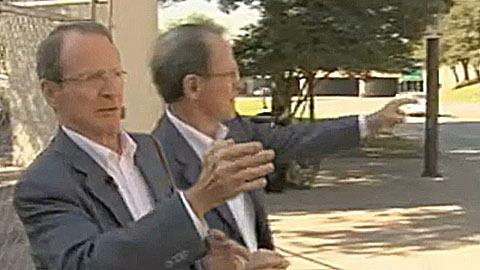 |
Former WFAA radio reporter Pierce Allman points toward the lamp post in front of the Depository (left) and toward the position of the president's car at the time of the first shot (right) in this composite image from a 2013 interview. [www.everythinglubbock.com]
During a recent speech at The Sixth Floor Museum at Dealey Plaza, author Max Holland said that he feared “that someday I’m going to turn into one of those people in Dealey Plaza who has laminated photographs trying to persuade everyone of my view of what happened.”
It would appear that his “nightmare” has come true, albeit minus the laminated photographs.
At the invitation of the museum, Holland presented his belief that Oswald’s first shot struck a traffic light mast pole and was deflected down toward the Triple Overpass where it wounded bystander James Tague – a belief that has no basis in fact as shown again and again on the pages of this blog.
See these previous articles for all the scoop:
After showing his audience the evidence that supposedly supports his thesis – evidence that has been thoroughly dismantled – Holland insists that you don’t have to believe his conclusions, although from his perspective, if you don’t you’re clearly an idiot.
“Now let me just point out here that our explanation of what happened is the plausible one – we believe,” Holland said, “in fact the only plausible one for why the bullet didn’t hit its mark when it was fired and where it went – but you don’t really have to believe it.
“You can believe that Oswald fired in the air to scare the pigeons off the roof. You can believe he had a bad case of buck fever and that he fired errantly into the asphalt but somehow no one saw the kind of volcanic little eruption that would have occurred if a bullet traveling at that velocity hit asphalt.
“But what you do have to believe is that the Zapruder film only captured the second and third shots. By his own account Abe Zapruder only heard two shots, he only saw two shots, and he only filmed two shots.” [Holland, Max, “From Rorschach Test to Time Clock: The Zapruder Film,” The Sixth Floor Museum, May 7, 2015, 55:02; 55:42]
Did you catch the circular logic? Zapruder only filmed two shots, according to Holland, because he only heard two shots and only saw the result of two shots. Seriously?
Another new witness
I’ve become used to Holland’s irrational logic, mockery, and disdain for the truth but just in case you find yourself succumbing to this latest dish of ego-laden drivel consider the only new revelation in Holland’s ongoing effort to convince everyone of his brilliance – yet another newly uncovered witness “supporting” Holland’s alleged traffic light pole deflection.
“…I developed other eyewitnesses. In fact, I’m still developing eyewitnesses,” Holland told the museum audience. “Take for example Pierce Allman. This is a still from the Dorman film…
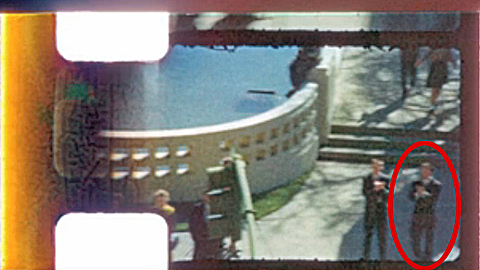 |
Holland slide of Dorman frame showing Allman [Sixth Floor Museum]
“Pierce Allman is the man on the right. Now if you look again at that still from the Secret Service restaging you have two men standing almost exactly in front of the steps where Pierce Allman and his colleague from WFAA were standing.
“And in 2013, an enterprising journalist asked Pierce Allman to stand in that same position and describe what had happened – what he had seen – and he said to that journalist, ‘At the time of the first shot, they were right about with the lamp post.’
“Well, there’s a lamp post not three feet from the black and white sign that Amos Euins had identified.” [Holland, Max, “From Rorschach Test to Time Clock: The Zapruder Film,” The Sixth Floor Museum, May 7, 2015, 41:47, 42:18]
Fact not fiction
As the 2012 article “Mr. Holland’s Opus” showed in spades, Amos Euins’ contemporary statements clearly refer to the R.L. Thornton Freeway sign further down Elm Street, not the U.S. Highway sign cluster at the head of the street as Holland suggests.
Now, Holland trots out former WFAA radio reporter Pierce Allman and insists that he too confirms an early shot. But that’s not true either, is it, Mr. Holland?
In the 50th anniversary interview Holland cites (available here), Allman said this:
ALLMAN: “The first shot they were right about, you know, with the lamp post [gesturing to his left] and – you know – you hear it and it was coming from straight in front and above [gesturing to his right-front] – and – you know – your reaction is ‘That - that’s not a shot. That doesn’t happen in your hometown….”
Allman points toward the TSBD, the source of the shots, and Holland's lamp post. [Sixth Floor Museum]
So in fact, Allman points to an area that is past his position when referring to the location of the limousine at the time of the first shot – not the lamp post in front of him and slightly to his right.
Location of the lamp post (red circle) Allman (red arrow) pointed to and the lamppost (yellow circle) Holland claims he indicated. [Sixth Floor Museum]
The lamppost that Allman is referring to is located at the former location of the R.L. Thornton Freeway sign. Gee, what a coincidence. Allman places the limousine at the same location indicated by Holland’s two other star witnesses – Amos Euins and Patricia Ann Donaldson; the moment after the limousine passed under the traffic light mast pole but before it passed under the Live Oak tree branches.
The real question is how Holland can look at the filmed interview of Allman and not know that he’s pointing to area considerably west of the lamp post he describes to his audience?
Eight years of deflection
It’s been eight years since Holland first proposed his theory of an early missed shot, fired before Zapruder began filming, and despite oodles of publicity he has yet to substantiate his theory with one verifiable fact.
Not only are his eyewitness accounts twisted like a pretzel to fit his preconceived notion, but by his own admission there is not one bit of physical evidence to support his deflection contention.
Indeed, late last month, a few weeks after Holland’s Sixth Floor Museum presentation, ballistic expert Luke Haag showed over 450 forensic scientists attending a conference in Dallas his peer-reviewed ballistic investigation into Holland’s theory which demonstrated that each and every one of Holland’s assertions about the potential deflection of one Oswald’s bullets by the traffic mast pole was physically impossible. It didn’t happen. It couldn’t have happened.
One has to wonder, in the face of all the evidence to the contrary, why Holland continues to cling to a false history of his own making?
He told the Sixth Floor Museum audience that the reason he started focusing on the first shot miss was because Secret Service agent Win Lawson was so insistent that there was a noticeable pause between the first shot and the second and third shots.
Yet, Holland has never explained why his own timing of the supposed shot sequence sounds like three evenly spaced shots?
Here’s the mp3 audio clip the authors sent to Holland eight years ago without a response:
Once again, we invite – no, we insist – that Holland listen to this clip and then publicly go on record stating whether or not he thinks this sounds like the last two shots are bunched together. Bet you won’t hear a peep out of Max.
Where’s the glory?
In the end, what difference would it have made even if Holland’s theory proved to be true (which of course, it hasn’t)? How would the fact that Oswald might have had an extra second or two (that’s a second or two more than we already know he needed) to fire all three shots alter our understanding of the assassination?
Holland proposed to his Sixth Floor audience that the entire history of the controversy over Oswald’s guilt and the criticism of the Warren Report would have been smothered.
“…the Warren Commission had to answer three questions – why hinged on who, and who was contingent on how, and how was the only one that the Commission had the complete power to absolutely resolve,” Holland said. “That they didn’t, eroded their credibility.”
Yet, Holland well knows that criticism of the official account of the assassination began long before the Warren Commission released their report with newspaper and magazine articles by Richard Dudman, Mark Lane, and others; and even entire books by Nerin E. Gunn and Joachim Joesten. This is basic JFK Assassination 101!
Does anyone believe that conspiracy theorists would have gone to sleep for five decades had the Warren Commission simply proven that Oswald fired an early missed shot? And on what factual basis would the Warren Commission have resolved the disposition of an early missed shot?
Hell, even Holland can’t muster up any evidence that can withstand the most basic peer review fifty years after the fact! Yet, we’re supposed to believe that all the controversy that followed in the wake of the Commission’s final report was because they muffed answering that one question. Now that’s classic Holland “logic.”
Mesmerized
For eight years, Holland has been claiming that we’ve all been too mesmerized by the Zapruder film, that we’ve been unable to think outside the box, and that only he has managed to figure out how it all happened.
Unfortunately, there are many media outlets far too eager to embrace unvetted musings about the assassination like Holland’s so long as it draws an audience.
From where we sit, Max Holland’s theory of deflection is less about an errant bullet and more about deflecting the truth. [END]
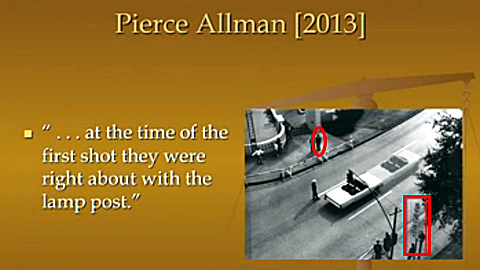 |
Holland slide of SS restaging and Allman's 2013 statement [Sixth Floor Museum]
“And in 2013, an enterprising journalist asked Pierce Allman to stand in that same position and describe what had happened – what he had seen – and he said to that journalist, ‘At the time of the first shot, they were right about with the lamp post.’
“Well, there’s a lamp post not three feet from the black and white sign that Amos Euins had identified.” [Holland, Max, “From Rorschach Test to Time Clock: The Zapruder Film,” The Sixth Floor Museum, May 7, 2015, 41:47, 42:18]
Fact not fiction
As the 2012 article “Mr. Holland’s Opus” showed in spades, Amos Euins’ contemporary statements clearly refer to the R.L. Thornton Freeway sign further down Elm Street, not the U.S. Highway sign cluster at the head of the street as Holland suggests.
Now, Holland trots out former WFAA radio reporter Pierce Allman and insists that he too confirms an early shot. But that’s not true either, is it, Mr. Holland?
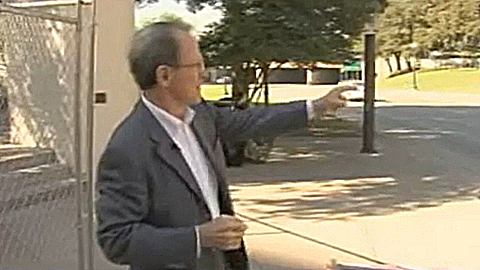 |
Pierce Allman points to where the limousine was at the time of the first shot. [Sixth Floor Museum]
In the 50th anniversary interview Holland cites (available here), Allman said this:
ALLMAN: “The first shot they were right about, you know, with the lamp post [gesturing to his left] and – you know – you hear it and it was coming from straight in front and above [gesturing to his right-front] – and – you know – your reaction is ‘That - that’s not a shot. That doesn’t happen in your hometown….”
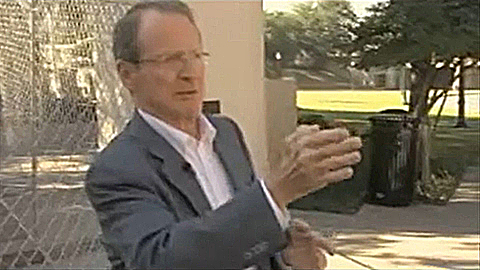 |
Allman points toward the TSBD, the source of the shots, and Holland's lamp post. [Sixth Floor Museum]
So in fact, Allman points to an area that is past his position when referring to the location of the limousine at the time of the first shot – not the lamp post in front of him and slightly to his right.
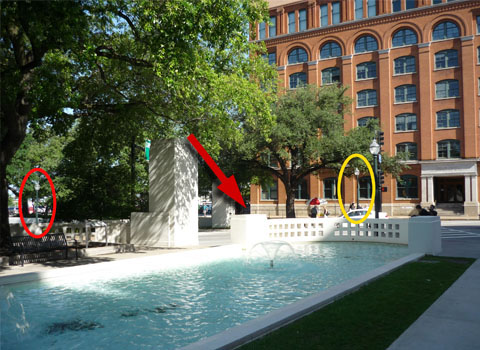 |
Location of the lamp post (red circle) Allman (red arrow) pointed to and the lamppost (yellow circle) Holland claims he indicated. [Sixth Floor Museum]
The lamppost that Allman is referring to is located at the former location of the R.L. Thornton Freeway sign. Gee, what a coincidence. Allman places the limousine at the same location indicated by Holland’s two other star witnesses – Amos Euins and Patricia Ann Donaldson; the moment after the limousine passed under the traffic light mast pole but before it passed under the Live Oak tree branches.
The real question is how Holland can look at the filmed interview of Allman and not know that he’s pointing to area considerably west of the lamp post he describes to his audience?
Eight years of deflection
It’s been eight years since Holland first proposed his theory of an early missed shot, fired before Zapruder began filming, and despite oodles of publicity he has yet to substantiate his theory with one verifiable fact.
Not only are his eyewitness accounts twisted like a pretzel to fit his preconceived notion, but by his own admission there is not one bit of physical evidence to support his deflection contention.
Indeed, late last month, a few weeks after Holland’s Sixth Floor Museum presentation, ballistic expert Luke Haag showed over 450 forensic scientists attending a conference in Dallas his peer-reviewed ballistic investigation into Holland’s theory which demonstrated that each and every one of Holland’s assertions about the potential deflection of one Oswald’s bullets by the traffic mast pole was physically impossible. It didn’t happen. It couldn’t have happened.
One has to wonder, in the face of all the evidence to the contrary, why Holland continues to cling to a false history of his own making?
He told the Sixth Floor Museum audience that the reason he started focusing on the first shot miss was because Secret Service agent Win Lawson was so insistent that there was a noticeable pause between the first shot and the second and third shots.
Yet, Holland has never explained why his own timing of the supposed shot sequence sounds like three evenly spaced shots?
Here’s the mp3 audio clip the authors sent to Holland eight years ago without a response:
Once again, we invite – no, we insist – that Holland listen to this clip and then publicly go on record stating whether or not he thinks this sounds like the last two shots are bunched together. Bet you won’t hear a peep out of Max.
Where’s the glory?
In the end, what difference would it have made even if Holland’s theory proved to be true (which of course, it hasn’t)? How would the fact that Oswald might have had an extra second or two (that’s a second or two more than we already know he needed) to fire all three shots alter our understanding of the assassination?
Holland proposed to his Sixth Floor audience that the entire history of the controversy over Oswald’s guilt and the criticism of the Warren Report would have been smothered.
“…the Warren Commission had to answer three questions – why hinged on who, and who was contingent on how, and how was the only one that the Commission had the complete power to absolutely resolve,” Holland said. “That they didn’t, eroded their credibility.”
Yet, Holland well knows that criticism of the official account of the assassination began long before the Warren Commission released their report with newspaper and magazine articles by Richard Dudman, Mark Lane, and others; and even entire books by Nerin E. Gunn and Joachim Joesten. This is basic JFK Assassination 101!
Does anyone believe that conspiracy theorists would have gone to sleep for five decades had the Warren Commission simply proven that Oswald fired an early missed shot? And on what factual basis would the Warren Commission have resolved the disposition of an early missed shot?
Hell, even Holland can’t muster up any evidence that can withstand the most basic peer review fifty years after the fact! Yet, we’re supposed to believe that all the controversy that followed in the wake of the Commission’s final report was because they muffed answering that one question. Now that’s classic Holland “logic.”
Mesmerized
For eight years, Holland has been claiming that we’ve all been too mesmerized by the Zapruder film, that we’ve been unable to think outside the box, and that only he has managed to figure out how it all happened.
Unfortunately, there are many media outlets far too eager to embrace unvetted musings about the assassination like Holland’s so long as it draws an audience.
From where we sit, Max Holland’s theory of deflection is less about an errant bullet and more about deflecting the truth. [END]





13 comments:
Dale's last sentence is sad, but true. Max Holland appears to be the latest in a long line of persons who, having gained notoriety and publicity for proposing a novel theory about the assassination, have now become "locked in" to their scenario and are either unwilling or unable to acknowledge any and all counter-evidence that proves them wrong.
Just hard to imagine that a missed shot happened in the manner Max Holland describes. Wouldn't such a missed shot have sent hordes of people scrambling for cover? No one near that sharp hairpin turn off of Houston onto Elm seems the least bit aware, nor concerned about an errant shot. Could it be because there was no errant shot to contend with?
There most assuredly was an early errant shot. However, there is no physical evidence to support Holland's traffic mast pole ricochet, no ballistic foundation to rest Holland's presumed physics upon, and no believable eyewitness support for an errant shot earlier than Zapruder's camera re-start at Z133. Despite Holland's foot stomping and shenanigans over the last eight years, he hasn't presented anything that establishes support for the timing or the impossible trajectory he imagines.
I too have my doubts about Holland’s quick first shot thesis, but I’m not sure I agree with your assessment of where Pierce Allman is pointing. In another videotaped interview, Allman appears to place the first shot directly across from him, pointing to the lamp post behind the traffic light mast. See this YouTube video at 1:10. https://youtu.be/20774ctM9GY
Tod, In the video you cite, Allman is **not** standing where he was on November 22nd. To be fair, he is not quite standing in the proper location in the video I cited either, however, my video citation is much closer to the actual spot, as seen in the Dorman film. Allman has consistently said that the limo passed his position before he heard the first shot, which means the limousine couldn't have been in line with the TSBD front entrance - as the YouTube video you cite indicates.
Dale,
I have tremendous respect for your work, but as I continue my own research into the first shot, I have concluded you are wrong on your assessment of Mr. Holland’s thesis. As to Pierce Allman, you are flat out wrong about where he places the first shot. I’ve watched numerous interviews of Allman and he is very clear that the first shot occurred immediately after the President limousine rounded the corner of Elm and Houston, well before the Thornton Expressway sign. There was no evidence that the first bullet was deflected by an Oak branch and the Haags work has debunked that notion. Common sense says Oswald tried to get the first and best shot before the car reached the tree. More importantly, however, I think you have to go back to the testimony of the Dealey Plaza witnesses. My own research shows that if you exclude those who actually witnessed the horror of the assassination, there is virtual unanimity as to the sequencing of the shots: A first shot, then a pause, followed by the last two shots bunched together. That is what virtually every witness recalls, IF they HEARD the assassination but didn’t see it. I am referring to the people along Houston, at the corner of Main and Houston, those riding further back in the motorcade and the people who watched from the entrance of the TSBD, who could not see the President’s car after it passed them. This is significant because there is an overwhelming consensus about this fact among those who heard but did not see, and it extends the span of all three shots when you put 6-7 seconds between the first and second shot. In addition, you have multiple eyewitness accounts that stated that they saw dust flying up from the pavement after the first shot. They contend this occurred just as the Limousine rounded the corner. But the clincher is the statement of the secret service agents in the follow up car, particularly agents Hickey and Bennett who recalled reacting to the sound of the first shot by looking around for what they thought was a firecracker. In the Zapruder film at frames 135-145, we see them doing exactly that, which strongly indicates that the first shot was fired BEFORE Zapruder started filming. Which means Oswald had almost 11 seconds to fire three shots. I’m not convinced the shot was deflected by the traffic light post. But I do think many Assassination researchers have fallen victim to the same error that tainted the Warren Commission-they didn’t completely trust the eyewitness accounts, particularly those accounts that were not marred by having visually witnessed the murder.
I’m sorry. I meant Zapruder frames 145-160. Bennett and Hickey are clearly straining to look at something, and according to the reports, they were looking for a firecracker or perhaps a blown out tire.
In addition, numerous witnesses were on record shortly after the assassination recounting conversations that occurred between the first and second shot. The general gist of these conversations went something like, “What was that sound? It sounds like a firecracker or a motorcycle backfire.” Then they heard the second shot. My question is how long does it take to hear the loud sound, process it in your mind and then say those words? About 6 or 7 seconds. Further evidence that there was a discernible pause between the first and second shots, which means the first shot occurred before many think and most likely when the limousine had just completed its turn at the corner of Elm and Houston.
Tod – Glad to see you’re still on the case since your postings in 2021 (above), investigating Holland’s shot sequence. I wonder though if you actually read the eight blog posts mentioned above? It doesn’t seem so, given your recent comments. When it comes to Mr. Allman and when the first shot occurred, you rely on the phrase “immediately after the presidential limousine rounded the corner of Elm and Houston” and “well before the Thornton Expressway sign”, for the limo’s position. However, as I demonstrated, from Allman’s location the limousine was in fact aligned with the Thornton sign a bit further up the street – not next to the sign, but aligned with the sign in the background. This places the limousine well past the position postulated by Holland. You also propose ignoring a good deal of eye and earwitnesses whose testimony apparently don’t agree with your narrative. This is called cherry-picking evidence. You claim the vast majority of earwitnesses bunched the last two shots closer in time than the first two. Yet a good many of the witnesses also claimed the shots were evenly placed. So, which is it? Eye and earwitness testimony can be tricky. I never trust it, but it can be useful if verifiable by other means. You also claim that six to seven seconds must have elapsed between the first two shots to fit what you call the time period necessary to allow the average person to respond verbally to the first shot – as some witnesses reported doing. I used a stopwatch to record my own simulated reaction time and found three to four seconds to be more than enough time. So, there’s no need to push back the time of the first shot to a period prior to the start of the Zapruder film. The clincher, you claim, is your observation that Secret Service agents Hickey and Bennet can be seen “clearly straining to look at something” (between Zapruder frames 145-160), which according to their later statements was “a firecracker or perhaps a blown-out tire.” You’ll have to admit that your ability to see Hickey and Bennet “clearly straining” is an invented observation since the Zapruder film does not have the resolution to enable anyone to see in which direction either man’s eyes are looking – only the direction in which their head is facing. More important, Agent Bennet, who is sitting the backseat on Hickey’s right, is not even visible (!) in the Zapruder sequence you referenced; being blocked from view by Agents Ready and Landis standing on the right-side running board. We agree that Holland’s theory of a traffic pole deflection of the first shot is nonsense. That’s good enough for me, and my main point in this series of blog posts. As for the rest, good luck with you search for the truth.
Thanks Dale. Your encyclopedic knowledge of the assassination is always big help in sorting this stuff out. I stand corrected about Bennett in the Z film; he is not visible as the Queen Mary rounded the corner. Hickey, however, is clearly visible and he leans so far to his left that he looks like he’s going to fall out of the car. It is as clear as day. It could be just a coincidence that he did that prior to the first shot rather because of it.
I acknowledge that Dealey Plaza witnesses differ in their recollection of the number of shots and the spacing. And it is always tempting to cherry pick. Even the best Assassination researchers do it. But I’m not doing that. To my point, if you segregate witnesses by location, the witnesses who were located further away and were not distracted by the activity inside and around the President’s car, are virtually unanimous in stating there were three shots with a longer, discernible pause between the first and second shot. I find these accounts to be very credible in that so many of them were given on the day of the shooting or the next day. Further, their recollections were not marred by the utter shock of actually witnessing this horrific and gruesome event. The variance in recollection is greatest among the witnesses who were close the President’s car at the time of the second and third shots.
I do have one question for you. Are you aware of any research regarding the possibility that Oswald missed on the first shot due to a gun or ammunition malfunction? Many witnesses have emphasized that the first shot sounded much different than the second two shots. Some claim that it sounded more like a cherry bomb or toy cannon exploding. Are you aware of any research into this possibility?
Tod - I know of no evidence of a rifle or ammunition malfunction related to any of the three shots.
The deconstruction of Max Holland’s work is very impressive. Does Mr. Myers have an opinion as to when the first shot was fired and, if so, what is the evidence to support that timing?
Mike - I've explained my position and the evidence to support it in many of the blog posts related to this series on Mr. Holland's theories. See the six links at the beginning of this post.
Thank you. I see. “Assuming a quarter of a second reaction time (a typical human startle response time) puts the first shot about 5 frames before Governor Connally’s reaction beginning at Z162, hence (Z155-157).”
Post a Comment